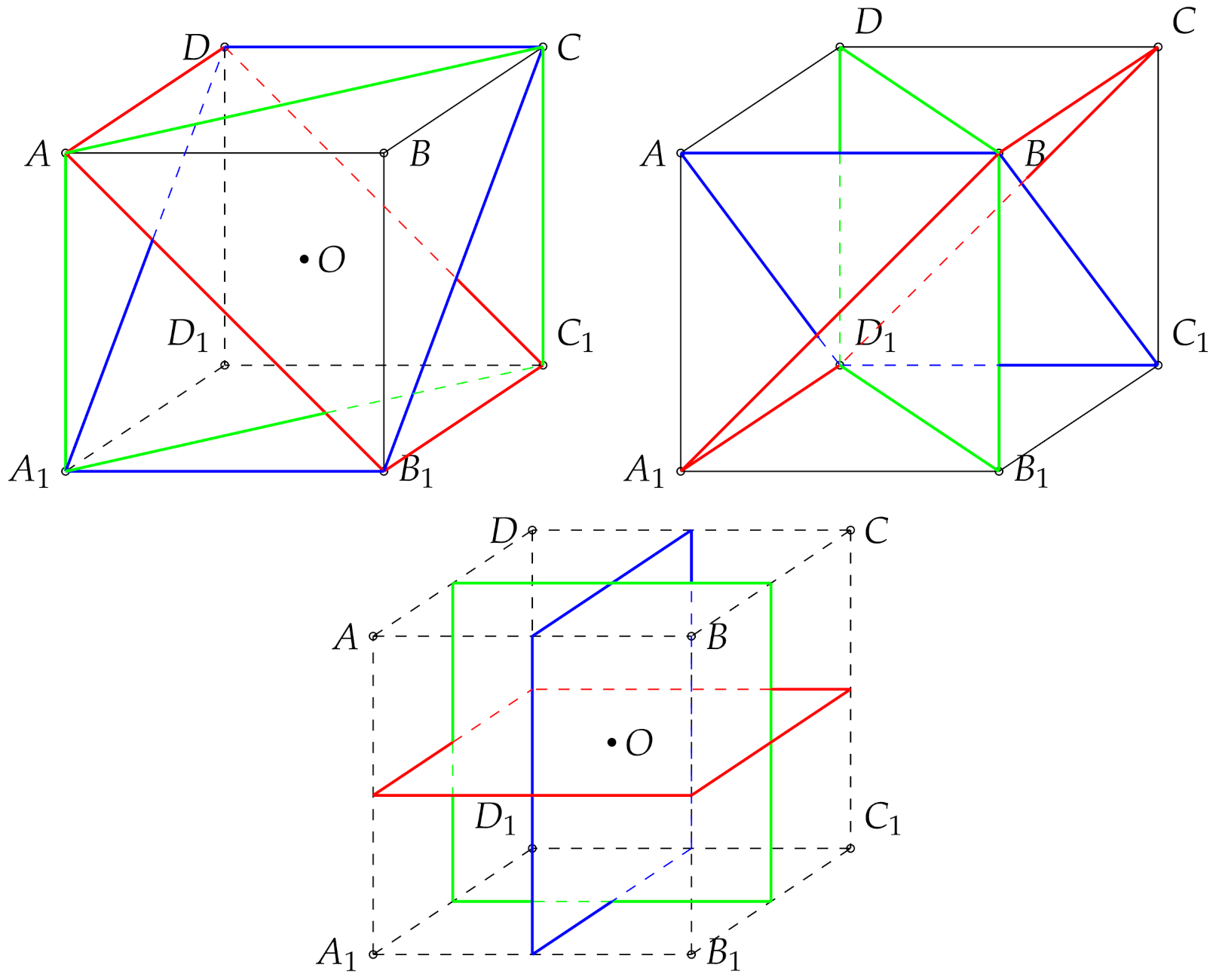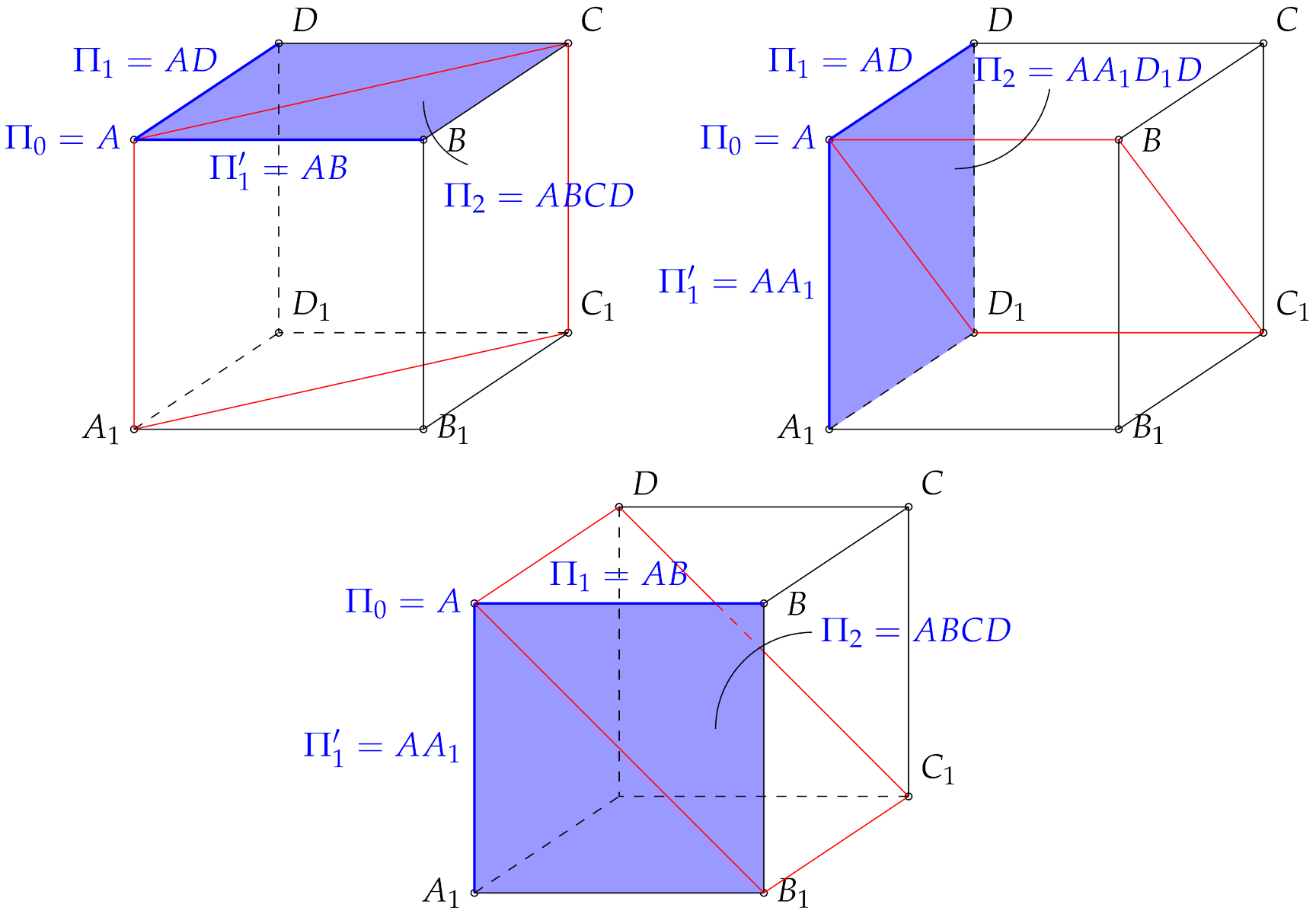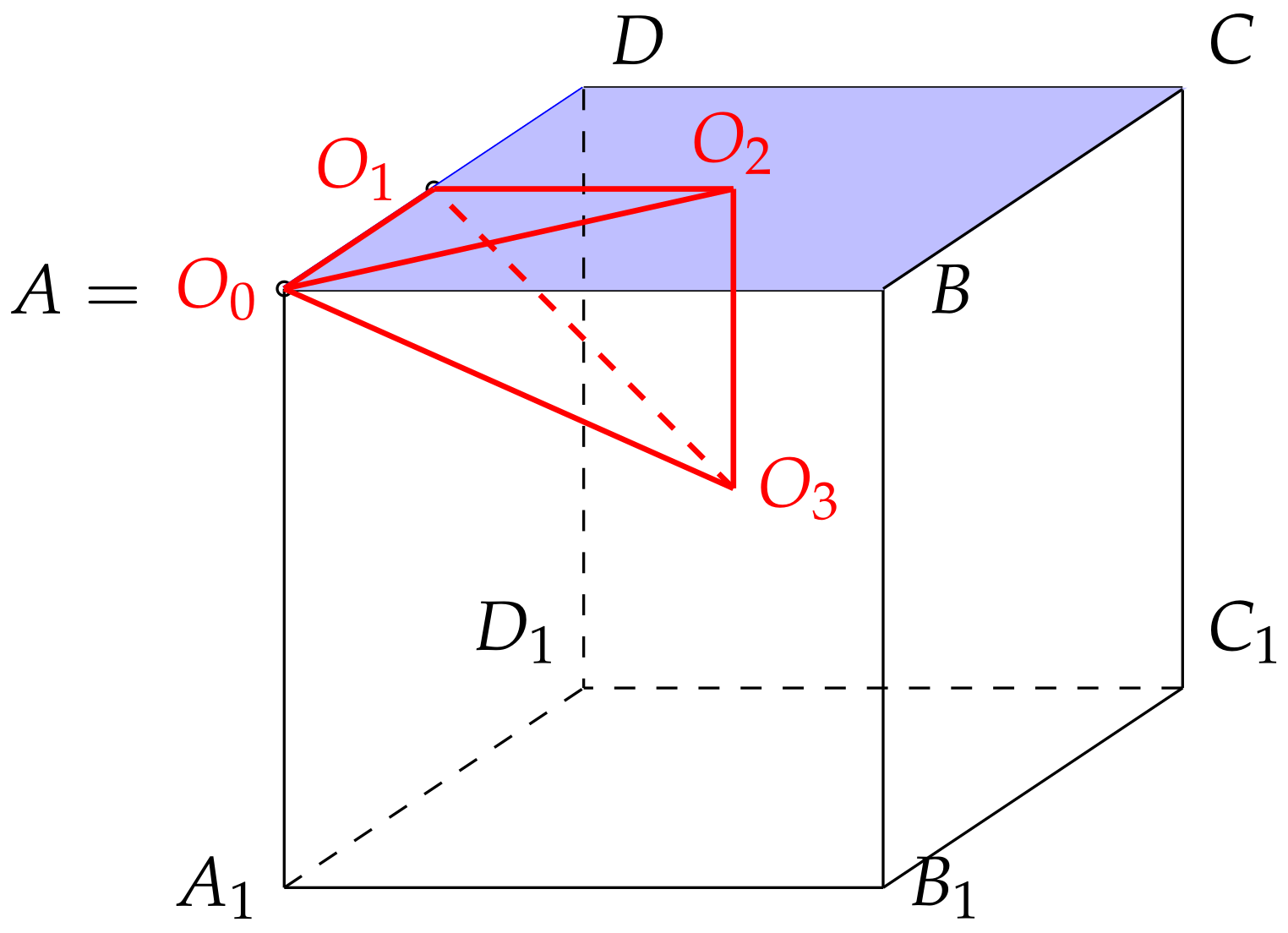1. Introduction
In this paper, we remind the reader of some well-known and some less-well-known terms concerning regular polytopes and their symmetry group. Using [
1], we show the terms in Euclid
n-dimensional space
and picture them considering the symmetries in a three-dimensional cube. The flag definition is mentioned as another point of symmetry view that we found in [
2]. We introduce the terms’ generalizations on the complex unitary space and introduce the idea of problems together with their solutions.
The generalized
n-cube
in
n-dimensional unitary space
was first described by Coxeter in [
3]. The
symmetries group is generated by reflections relatively to the
-dimensional hyperplanes and it is denoted with
. We studied the properties of the polynomial invariants’ algebra
relatively to the generalized
n-cube
symmetry group
. In [
4], the basis polynomial invariants are given with even exponents but without any proof. The author only mentioned the fact that the polynomials were based on Pogorelov’s polynomials for reflections’ symmetries. We thus try to shed light on the results presented in Rudnitsky’s work ([
4]).
We conjectured that it is possible to construct the explicit polynomial invariants with the odd degrees and complete the all-degree generators of the polynomial algebra . To this aim, we used a suitable differential operator.
We investigated the available literature searching for other methods giving results considering basic reflections’ algebra invariants. More general unitary reflection groups known as
were described in [
5,
6], but no method giving results similar to ours was presented. Accordingly, there is no particular reason for us to mention them. This was also found to be the case by the authors of several other references that we previously mentioned: it was the lack of available literature that prompted us to submit this result together with pictorial representations of the basic concepts.
2. Regular Polytopes and Their Symmetries Groups
Consider
with the ordinary orthogonal basis
such that any point
is represented by
. For the
n-cube centered in the coordinates’ origin, there are hyperplanes generating invariant reflections:
Hyperplanes (
1)–(
3) are consecutively ordered on
Figure 1 with a cube in
. Reflections’ invariant planes are colored by green, blue and red according the linguistic order of the coordinate appearing within equations.
Every hyperplane in
Figure 1 generates the reflection which is a symmetry of the cube of order two. If it is repeatedly applied twice, then all points attend a position identical to that before the application:
Two composited symmetries again provide the symmetry of the cube. The compositing is commutative, associative, and invertible, so the symmetries on a cube form a group. In , this group is called the real n-cube symmetry group and it is denoted by . The group degree is the number of its elements, denoted by .
According to (
3), a reflection symmetry in
was obtained by a sequence of the coordinate transpositions. According to (
1), a reflection was obtained by taking the opposite coordinate value while the others remain, and (
2) represents the both. Since any symmetry from
is a permutation of its coordinates possibly taking the opposites of several of them, then
.
Note that in
Figure 1, there are nine hyperplanes generating other symmetries as reflections’ compositions within the cube. For a general dimension
n, there are
such hyperplanes, counting them by (
1)–(
3):
By the hyperplanes in Equations (
1)–(
3), we rewrite the polynomial invariants constructed in [
1,
7]:
for natural numbers
If only the points coordinate from any of the reflection hyperplanes (
1)–(
3) and are inserted in (
5), then the polynomial value remains.
For natural
r, polynomials (
5) are within the algebra
consisting of polynomial invariants relatively to the symmetries group
. In ([
8]), it is given that (
5) has the following explicit form:
with polynomials:
The mentioned symmetry group degree calculation was also achieved after Definition 2, considering the flags within the regular polytope in .
Definition 1 (Incidence and flag). Two subspaces, with dimensions are incident if one of them is a proper subspace of the other. The flag is a figure consisting of mutually incidental elements with consecutive dimensions .
Within the cubes
in
Figure 2, three red colored reflection hyperplanes are transposed on colored pairs of flags
and
from each into another. The next definition from [
2] is very natural.
Definition 2 (Regular polytope by [
2]).
The regular polytope is a polytope whose symmetry group is transiting on flags. This means that every flag is translated into another flag by the symmetry. Since the symmetry group
is strictly transitive on flags, the
n-cube is a regular polytope, and the
degree is equal to number of flags. There are
vertices, and for each of them there are
n one-dimensional subspaces called edges. Each such edge belongs to
two-dimensional subspaces called planes. Any plane is within
subspaces with dimension 3, etc. Finally, there is only one hyperplane at the end of the flag. The order of the symmetries group
is thus again
. See [
9] for generalisations.
In [
2], it was proven by induction that
can only be generated by
n reflections. On
Figure 1, we presented three basis reflection hyperplanes of the group
with the flags
from the point
A on
Figure 2. The hyperplanes are determined with triples
,
, and
, and are red colored. In
Figure 3, the red points are settled in the centers of each flag element and on the center of the
n-cube.
3. Generalized -Cube Symmetry Group
In
, we centered the two-length cube in origin. In the orthogonal basis mentioned above, the vertices of the cube are given with summations
Note that different vertices are obtained by choosing so that in each, the summation comes above the prime second root from the unit calculated as with . There are therefore vertices.
The Euclid space
over real numbers and the unitary space
over complex numbers have the same orthogonal basis:
. We generalize the term of the real
n-cube in the
n-dimensional complex unitary space. More details are given in [
10].
Definition 3. The generalized n - cube in is polytope with vertices given by the sums:
Different vertices are created by choosing a different that is coming above the prime m-th root from the unit calculated as . There are therefore vertices.
Let
be the cube
symmetries group. Symmetries are generated by reflections that replace the coordinates. They are of order two, since its double returns the cube to its previous position. Other symmetries are related to complex planes that create each unitary space coordinate. For more details see [
11].
If we fix coordinates among all coordinates from each vertex of the cube , then we obtain edges and each is a part of a one-dimensional complex space . In doing so, the polytope can be represented as a Descartes product of n edges . In each one-dimensional complex edge within cube , there is a symmetry of order m generated by the regular m-gon determined with m complex roots of unity.
For
n dimensions of the space, there are
coordinate combinations. Within each combination, there are
m possible symmetries. Thus, the
group is of order
. Analogue to (
1)–(
3), the symmetries are generated by reflections of order 2 relatively to hyperplanes with equations:
and reflections of order
m relatively to the coordinate hyperplanes
.
In , the scalar product is defined with , where for with real and . The same bases of and allow us to continue with the notation for complex coordinates’ vectors.
In [
4], the Pogorelov polynomials of degree
are defined by:
where
are normal unit vectors relatively to hyperplanes generating reflections
from
. Within [
4], the normal vectors
are explicitly given by
Because any reflection relative to the hyperplane with (
11) does not move the points within the hyperplane, so polynomial calculations (
10) remain if they are calculated by hyperplane points’ coordinates. Thus, Pogorelov polynomials given by (
10) belong to the algebra
which consists of polynomial invariants relatively to the symmetry group
.
In [
4], the author establishes the relations for
m and
n that allow
algebra generators to be represented with (
10). If
m is even and if
, then the polynomials from (
10) are given with:
where:
If
m is even within (
12) and (
13), then
and
.
On the contrary, if
m is odd, then
and
with
for
n being even and
for odd
n. This statement is given in [
4] in the form of a Theorem without any explicitly given proof.
Theorem 1. The polynomials given by (12) are the generators of polynomial invariants algebra with even degree and for 2 cases: - -
For any n which provides ;
- -
For , , here if and if .
Together with all the explained above, we noted that for an odd m, the polynomials of type have and will appear as the basis invariants for algebra in the unitary spaces of any dimension n.
4. Main Result
Naturally, the problem of constructing the polynomial invariants’ algebra bases for
with the odd degree that are based on Pogorelov polynomials arises. In the next Theorem, we present invariants relatively to (
12) with the odd degree
.
Theorem 2. Assume all conditions from Theorem 1. Then, the basis polynomial invariants for the algebra relatively to the group are given with:
with , where for n being even and for odd n. Proof We apply a differential operator of
m-th degree given by
Applying (
15) to the polynomials
with even degrees
given by (
12) and (
13), we obtain polynomial invariants for
with odd degrees
. If (
12) and (
13) are relatively invariant to the points
that belong to reflections’ hyperplanes that generate symmetries in
, then their
m-th partial derivatives are still invariants relatively to the same points
.
It is a consequence that polynomials are analytic complex functions and a compositing derivative that don’t change the linear structure of the polynomials’ origin given with (
10). Namely, those parts in (
10) that equal zero, will equal zero in their derivatives.
The first part of (
14) is that of partial derivatives’ consequence that gives:
Together with (
12), we obtain the derivative of the first part:
Introducing differential operator:
we will prove the second part of (
14). Since the value
m is odd and values
r are even, the second part in (
14) is the basis polynomial invariants
with odd degrees
relatively to the
symmetries group.
We analyze the case
without losing any generality of the proof, since the further can be analogously obtained. Since potentials are analytic functions, derivative techniques are equivalent as in real variable cases. We analyze the case
at the first place:
For
, we have the following:
The full announcement gives:
After some algebra, we obtain the odd degree as before:
As such, every bracket consisted of the four vanished members, which finally results as
Then, if
, we obtain the odd degree again:
The verification will appear with the calculating derivative with
as much longer; therefore, we left the majority to the reader. It starts ordinarily, and after some algebra, we have:
Introducing the following notation and knowing that:
we have:
Note that
and
. Using the notations defined above, we proceed with the calculations as follows:
Finally, with
, we have an odd degree basis invariant:
After all above, we set
, and obtaining the following:
After the pretty long and exhausted calculus, we have:
Formulas (
16) and (
18) together form basis invariants (
14) with odd degrees
for the polynomial invariants’ algebra
relatively to group
and based on the Pogorelov polynomials. All the algebra
generators are now explicitly obtained regardless of degree parity. □
5. Conclusions
In this article, we constructed odd-degree polynomial invariants algebra
generators. As such, we used the suitable differential operator (
15) acting on polynomial invariants
in (
12) and (
13) with
.
In doing so, we introduced the polynomial invariants of the symmetry group generated by reflections we pictured in the 3-dimensional real space. We also introduced the term of flag as a possibility for the symmetry group investigation.
The original article [
4] presented several results without exact proof. However, it was not entirely clear why the polynomial invariants’ exponents in (
10) were of even
and consequently must be
. If the author in [
1,
7] simply found even exponents
since
n-cube was settled in the origin and symmetry degree, then accordingly (
1) is two, and we conjecture that the exponent in (
10) might be
instead of
. Our result can confirm the conjecture.
Further investigation may yield the answer. It will be interesting to generalize the flag term into generalized n-cube investigations. After all, unfinished articles are motivating further research studies.







